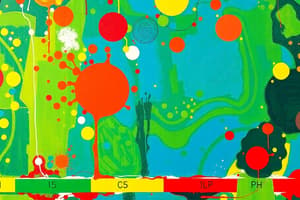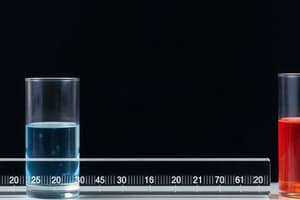Podcast
Questions and Answers
What defines potential energy?
What defines potential energy?
- Energy that is actively causing movement
- Energy stored and capable of doing work (correct)
- Energy that cannot be transformed
- Energy involved in rapid reactions
What does a neutral solution have on the pH scale?
What does a neutral solution have on the pH scale?
- pH of 10
- pH of 14
- pH of 0
- pH of 7 (correct)
Which statement about acids is accurate?
Which statement about acids is accurate?
- Acids are neutral substances
- Acids donate protons (correct)
- Acids have a pH greater than 7
- Acids are proton acceptors
What occurs when products contain more potential energy than reactants?
What occurs when products contain more potential energy than reactants?
How does temperature affect the rate of a chemical reaction?
How does temperature affect the rate of a chemical reaction?
What happens during a change of one unit on the pH scale?
What happens during a change of one unit on the pH scale?
Which of the following statements is true regarding bases?
Which of the following statements is true regarding bases?
What is true about the relationship between pH number and H+ concentration?
What is true about the relationship between pH number and H+ concentration?
What is the normal pH range for human blood?
What is the normal pH range for human blood?
What condition results when blood pH drops below 7.35?
What condition results when blood pH drops below 7.35?
How does the concentration of reactants affect the rate of a chemical reaction?
How does the concentration of reactants affect the rate of a chemical reaction?
What happens to the rate of chemical reactions during a fever?
What happens to the rate of chemical reactions during a fever?
What is the role of buffers in a solution?
What is the role of buffers in a solution?
What is a characteristic of Carbon Dioxide (CO2)?
What is a characteristic of Carbon Dioxide (CO2)?
Which statement best describes water in terms of its molecular structure?
Which statement best describes water in terms of its molecular structure?
How does the body maintain pH homeostasis?
How does the body maintain pH homeostasis?
Which of the following is NOT a role of water in living organisms?
Which of the following is NOT a role of water in living organisms?
What distinguishes inorganic molecules from organic molecules?
What distinguishes inorganic molecules from organic molecules?
Which of the following groups are NOT considered major organic molecules essential for living organisms?
Which of the following groups are NOT considered major organic molecules essential for living organisms?
What mechanism contributes to the diversity of organic molecules?
What mechanism contributes to the diversity of organic molecules?
Which statement about inorganic substances is true?
Which statement about inorganic substances is true?
Which combination of atoms can form the carbon framework in large molecules?
Which combination of atoms can form the carbon framework in large molecules?
How did the understanding of organic and inorganic substances evolve with time?
How did the understanding of organic and inorganic substances evolve with time?
Which of the following elements is critical in forming covalent bonds that make up organic molecules?
Which of the following elements is critical in forming covalent bonds that make up organic molecules?
What is the composition of carbohydrates?
What is the composition of carbohydrates?
Which of the following statements about phospholipids is true?
Which of the following statements about phospholipids is true?
Which group of organic molecules is NOT one of the four major groups essential to living organisms?
Which group of organic molecules is NOT one of the four major groups essential to living organisms?
What type of molecule are monosaccharides classified as?
What type of molecule are monosaccharides classified as?
Eicosanoids are derived primarily from which type of molecule?
Eicosanoids are derived primarily from which type of molecule?
What type of bond joins disaccharides?
What type of bond joins disaccharides?
In the context of lipids, which characteristic describes the nonpolar end of a phospholipid?
In the context of lipids, which characteristic describes the nonpolar end of a phospholipid?
What type of carbohydrate consists of many monosaccharides linked together?
What type of carbohydrate consists of many monosaccharides linked together?
What is the primary function of amino acids in the body?
What is the primary function of amino acids in the body?
Which of the following best describes enzymes?
Which of the following best describes enzymes?
What composes the building blocks of nucleic acids?
What composes the building blocks of nucleic acids?
Which sugar is found in ribonucleic acid (RNA)?
Which sugar is found in ribonucleic acid (RNA)?
Which of these molecules serves as the energy currency of cells?
Which of these molecules serves as the energy currency of cells?
What type of molecule is DNA primarily composed of?
What type of molecule is DNA primarily composed of?
Which of the following is a characteristic of essential amino acids?
Which of the following is a characteristic of essential amino acids?
Which of the following pairs are classified as double-ringed organic bases?
Which of the following pairs are classified as double-ringed organic bases?
Flashcards are hidden until you start studying
Study Notes
The pH Scale
- Indicates the concentration of hydrogen ions (H+) in a solution
- Scale ranges from 0 to 14
- A neutral solution has a pH of 7.0 (H+ = OH-)
- An acidic solution has a pH less than 7.0 (H+ > OH-)
- A basic or alkaline solution has a pH greater than 7.0 (H+ < OH-)
- The pH number and H+ concentration are inversely related: the lower the pH, the higher the H+ concentration
- A change of one unit on the pH scale represents a 10-fold change in the H+ concentration
- Normal pH range for human blood is 7.35 to 7.45
- Acidosis occurs when blood pH drops below 7.35
- Alkalosis occurs when blood pH rises above 7.45
Salts
- A compound consisting of a positive ion other than H+ and a negative ion other than OH-
- Formed by the reaction of an acid and base
Buffers
- A chemical that resists pH changes when either an acid or base is added to a solution
- When an acid is added to a buffered solution, the buffer binds to H+, preventing a decrease in pH
- Important for maintaining homeostasis by keeping body fluid pH within a narrow range
Oxygen and Carbon Dioxide
- Oxygen (O2)
- Small, nonpolar, inorganic molecule
- Consists of two oxygen atoms bound by a double covalent bond
- Essential for most living organisms
- Carbon Dioxide (CO2)
- Consists of one carbon atom and two oxygen atoms
- Produced when food molecules (e.g., glucose) are metabolized within cells
- Eliminated as a metabolic by-product and exhaled during respiration
Water
- Inorganic molecule consisting of an oxygen atom joined by polar covalent bonds to two hydrogen atoms
- Essential for survival and plays crucial roles:
- Stabilizing body temperature
- Providing protection
- Facilitating chemical reactions
- Transporting substances
Organic Molecules
- Contain carbon
- Carbon atoms bound together by covalent bonds form the framework of many large molecules
- Variety in molecules due to:
- Variation in the length of carbon chains
- Combination of atoms bound to the carbon framework
Major Organic Molecules Essential to Life
- Carbohydrates
- Lipids
- Proteins
- Nucleic Acids (DNA & RNA)
Carbohydrates
- Composed of carbon, hydrogen, and oxygen atoms
- Smallest carbohydrates are monosaccharides (simple sugars)
- Disaccharides: formed when two monosaccharides are joined
- Polysaccharides: consist of many monosaccharides bound in long chains
Lipids
- Composed of carbon, hydrogen, and oxygen but with a lower proportion of oxygen than carbohydrates
- Insoluble in water but soluble in organic solvents such as ether or alcohol
- Include:
- Fats
- Phospholipids
- Eicosanoids
- Fats
- Saturated: contain only single covalent bonds between carbon atoms (butter, lard, and animal fat)
- Unsaturated: contain one or more double covalent bonds between carbon atoms (olive oil, peanut oil, and vegetable oils)
- Polyunsaturated: contain two or more double covalent bonds (safflower, sunflower, corn, and fish oils)
- Phospholipids
- Important structural components of cell membranes
- Contain a phosphate head (hydrophilic) and two fatty acid chains (hydrophobic)
- Eicosanoids
- Regulatory molecules derived from fatty acids
- Important in inflammation and blood clotting
Proteins
- Large molecules that contain carbon, hydrogen, oxygen, and nitrogen
- Made up of building blocks called amino acids
- The body can synthesize 12 amino acids, but the other 8, called essential amino acids, must be obtained from the diet.
- Important functions include:
- Regulation of chemical reactions
- Providing framework for tissues
- Enzymes: protein catalysts that increase the rate of chemical reactions without being permanently changed
Nucleic Acids: DNA & RNA
- Large molecules composed of carbon, hydrogen, oxygen, nitrogen, and phosphorus
- Consists of building blocks called nucleotides
- Each nucleotide contains a sugar (monosaccharide), a nitrogenous base, and a phosphate group
- DNA contains deoxyribose as its sugar, while RNA contains ribose.
- Organic Bases:
- Single-ringed molecules: Thymine, cytosine, and uracil
- Double-ringed molecules: Adenine and guanine
- Deoxyribonucleic Acid (DNA)
- The genetic material of cells
- Copies of DNA are transferred from one generation of cells to the next
- Contains information that determines the structure of proteins
- Ribonucleic Acid (RNA)
- Plays a crucial role in protein synthesis
Adenosine Triphosphate (ATP)
- Consists of adenosine (the sugar ribose with the base adenine) and three phosphate groups
- Often called the energy currency of cells because it can both store and provide energy
Studying That Suits You
Use AI to generate personalized quizzes and flashcards to suit your learning preferences.





